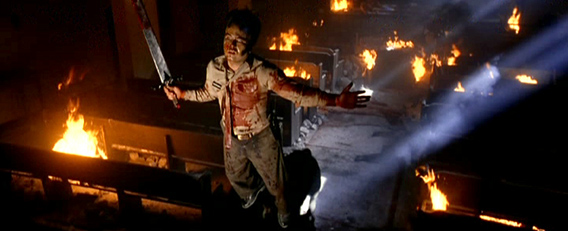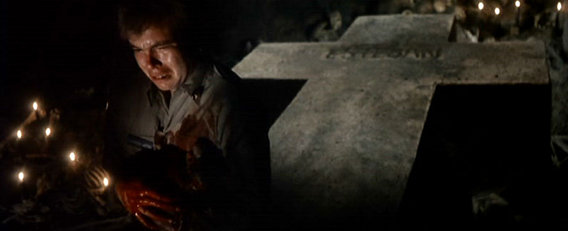
You could be forgiven for spending the first hour of Eric Weston’s horror drama Evilspeak wondering why on Earth it would have been included amongst the ‘video nasties’ during the mid-1980s. After all, it was relatively blood-free, inoffensive and the two brief moments of nudity were far less graphic than scenes that were included uncut in more mainstream pictures. But then, as the tension begins to build towards its inevitable climax, the film would subject the viewer to a sequence that would challenge that last sacred taboo – religion. Standing over his alter, Reverend Jameson speaks to the young group of cadets about their upcoming game and the overall game of life, when a pulse suddenly appears on the palm of the statue of Christ that hangs behind him. A stigmata wound is formed and blood begins to drip down onto his bible. Turning around to see a large nail slowly forcing its way out of the wound, he barely has time to react before the sharp implement is sent hurtling across the room and straight into his forehead.
Weston had briefly dabbled with acting during the 1970s with a string of forgettable films before deciding to direct his first feature film. Upon reading The Foundling, a screenplay by first-time writer Joseph Garofalo, Weston became intrigued by the premise and decided that it would make an interesting movie. But he had ideas of his own; realising that the story needed some work he wanted to add a new element to the story, one that would involve a computer. Filmmakers during the early 1980s had become obsessed with the possibilities of what computers and artificial intelligence could create, resulting in such varied offerings as Tron, Wargames, Electric Dreams, Weird Science and Deadly Friend. An additional element added to this concept would be one of teenage alienation, something that ever viewer could identify with to some degree. The film’s protagonist, Stanley Coopersmith, would be the class nerd; a victim of the school bullies and a student so useless and insecure that even his teachers have little tolerance for him.
The financial support that Weston would require came from two sources. The first were local doctors who had expressed interest in investing in a film project, whilst the second was from someone within the industry. Lebanese producer Sylvio Tabet would soon became known for his successful series of Beastmaster films, but in 1980 he was still a struggling businessman who was responsible for the production of several underrated exploitation flicks. His most impressive was Fade to Black, a low budget thriller written and directed by Vernon Zimmerman that told of a film fanatic who is scorned one too many times by both the local bullies and the girl of his dreams, causing him to adopt the images of his favourite fictional characters (including Dracula, Hopalong Cassidy and even Cary Grant in To Catch a Thief) to exact bloody revenge. Much like with Evilspeak, the script dealt with themes of teenage angst that would be manifested into violence.
The script for what was to become Evilspeak would go through around ten different drafts, as both Weston and Garofalo attempted to flesh out the characters and give the story a more even pace. At the centre of the tale is Coopersmith, a welfare student at the prestigious John Paul Jones Military Academ who is singled out as a loser by both his classmates and faculty, often being the butt of countless jokes and cruel taunts. As every underdog dreams about getting revenge on their bullies, the story has a universal appeal, but Weston and Garofalo’s script would also include black magic, Satanism and technology. Instead of featuring a graphic decapitation every five pages as had become common at that time, they instead tried to hold back the gruesome violence until the final few pages, concentrating on character development for the majority of the story.
With the required $1,000,000 budget in place, Weston began a search for suitable actors and behind the scenes talent to help bring their story to life. For the role of Coopersmith, the filmmakers eventually settled on Clint Howard, whose older brother, Ron, had become a household name thanks to his role as Richie Cunningham in the hit show Happy Days. Despite only being twenty-one, Howard already had almost two decades worth of acting experience and so was able to handle such a challenging part. Having briefly appeared in the likes of The Fugitive and Star Trek, Howard had also co-starred in his brother’s directorial debut, Grand Theft Auto, as well as the Ramones comedy Rock ‘n’ Roll High School. The part of Reverend Jameson would be portrayed by Joseph Cortese, a relative newcomer to the industry, whose subsequent work would involve mostly television appearances, aside from the critically acclaimed drama American History X.
Principal photography took place over a three-week period in Santa Barbara and South Central Los Angeles, where the production managed to obtain the use of a derelict church, which they would have to renovate to make it habitable. One evening after a particularly gruesome day of shooting, Howard was heading home when he pulled up at a set of traffic lights next to another car. Casually looking around, he sees the woman nearby looking at him nervously and then realises that he is still in his bloodied uniform that he had worn for a scene. One grin from the young actor and the woman promptly wound her window up and locked the door. With the final act being particularly gruesome, the filmmakers would require the assistance of a talented group of make-up artists. The producers eventually settled on Allan A. Apone, the founder of Hollywood-based studio Makeup & Effects Laboratories (MEL), who would oversee the effects for the movie. Apone would later work on the likes of Friday the 13th Part III, The Return of the Living Dead and several projects for Charles Band’s Empire.
Evilspeak was released in North America on February 26 1981, almost six months after it had first been screened in France. To avoid being rated X, the distributors, The Moreno Company, would allow severe cuts to the movie, removing much of the graphic violence (including a sequence in which a naked woman in forced into a bath by hungry pigs and then devoured). In total, over eleven minutes would be removed by the company in order to allow the film to be released. The movie was submitted to the BBFC and released by Videospace in August 1983. When videos were ordered to be certified to comply with the Video Recordings Act 1984, which would first come into effect on September 1 1985, many films were refused classification and dubbed video nasties. Evilspeak would suffer this fate when it was added to list in March 1984. It would later be resubmitted to the BBFC in 1987 and three minutes thirty-four seconds would be removed, primarily due to the excessive gore and elements of Satanism. The film would eventually be granted an uncut release on July 20 2004, with previously unseen footage added.


4 Responses to Human Blood Required: The Making of Evilspeak